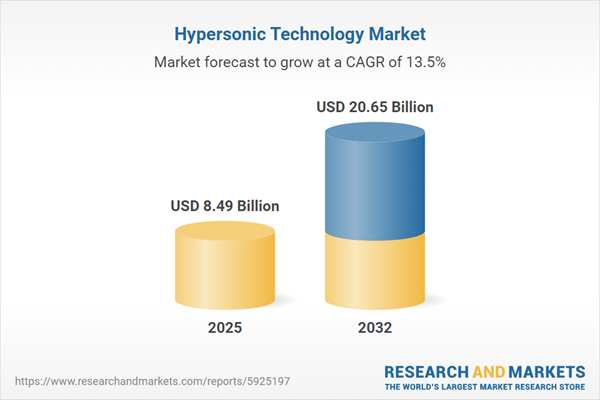Speak directly to the analyst to clarify any post sales queries you may have.
The hypersonic technology market is reshaping global aerospace and defense capabilities, requiring senior decision-makers to prioritize strategic adaptation and long-term planning as new solutions and mission requirements emerge.
Market Snapshot: Hypersonic Technology Market Growth and Outlook
The global hypersonic technology market reached USD 7.47 billion and is projected to grow to USD 20.65 billion by 2032, representing a robust compound annual growth rate (CAGR) of 13.54%. Advancements in propulsion technologies, improvements in high-performance materials, and heightened military modernization efforts are shaping this market's trajectory. The sector is experiencing increased momentum for commercial use cases, such as ultra-fast passenger and cargo transport, alongside the next generation of defense systems. Leading industry incumbents and emerging entrants are accelerating innovation and leveraging partnerships to address global security dynamics and evolving mission profiles. Collaboration across technologies and sectors is rapidly enabling solutions better aligned to operator and market demands.
Scope & Segmentation of the Hypersonic Technology Market
- Platform Types: Manned and unmanned aircraft, ballistic and cruise missiles, and re-entry vehicles are tailored for civil, logistics, and defense operations in diverse operating environments.
- Propulsion Systems: Ramjets, scramjets, turbine-based propulsion, and both liquid- and solid-fueled engines, alongside rocket ejector systems, address a full range of performance and mission requirements.
- End Users: Organizations such as satellite launch operators, space tourism firms, defense agencies, government institutions, and research entities deploy specialized hypersonic vehicles for logistics, innovation trials, and national security needs.
- Applications: Market utilization extends to ultra-fast transportation, advanced surveillance missions, targeted reconnaissance, secure real-time communications, and precision targeting for both commercial and defense clients.
- Range Variants: Platforms vary from short-, medium-, to long-range, meeting tactical, operational, or strategic imperatives and adapting to specific mission durations or theaters.
- Component Types: Core subsystems include advanced navigation systems, high-fidelity seeker technology, engineered fuel compositions, efficient air intakes, enhanced thermal protection solutions, and high-strength metallic alloys, each contributing to reliability and operational safety.
- Geographical Reach: The market's footprint spans the Americas, Europe, Asia-Pacific, and Middle East & Africa, featuring centers of innovation in the United States, China, India, Japan, United Kingdom, Germany, France, Australia, and Brazil to support local compliance and user expectations.
- Key Industry Players: Major companies such as Lockheed Martin, Raytheon Technologies, Northrop Grumman, Boeing, BAE Systems, MBDA, Safran, Airbus, Aerojet Rocketdyne, and General Electric establish industry norms and set the pace for technology advancements.
Key Takeaways for Senior Decision-Makers
- Strategic flexibility and effective resource management are vital to achieve competitive positioning as adoption rates for hypersonic technologies grow across both civil and defense applications.
- Collaboration between public agencies and private industry accelerates innovation cycles and enables organizations to better meet development and operational timelines.
- Continued advances in propulsion and thermal protection expand mission flexibility, enhancing rapid deployment, range, and targeting capability in diverse scenarios.
- Facing an increasingly dynamic landscape, organizations are advised to invest in adaptable business models and prioritize workforce skill development to maintain performance and foster innovation.
- Emerging digital engineering tools and artificial intelligence are optimizing engineering processes, safeguarding investments in modular, upgradeable hypersonic systems.
- Adhering to evolving regulatory standards is crucial for market compliance and stakeholder trust, particularly as safety requirements shift at both domestic and international scales.
Tariff Impact on Hypersonic Technology Supply Chains
Forthcoming U.S. tariff policies anticipated in 2025 are expected to affect supply chain economics for critical materials essential to hypersonic platform production. To address this, sector leaders are increasing domestic sourcing initiatives, expanding and diversifying supplier partnerships, and integrating additive manufacturing processes, all aimed at maintaining stable production and mitigating risks from global supply volatility.
Methodology & Data Sources
This report draws on executive-level interviews, first-hand facility observations, integration of multiple proprietary data streams, and a comprehensive review of technical literature to deliver recommendations grounded in the operational realities of the hypersonic technology sector.
Why This Report Matters
- Delivers a strategic evidence base for capital allocation and supply-chain management in a rapidly evolving technological environment.
- Enables organizations to identify and act on regional strengths while monitoring emerging competitors and regulatory changes.
- Equips leaders with actionable insights for developing resilient, adaptive operating models that can weather sector disruptions with minimal risk.
Conclusion
Achieving success in the hypersonic technology market will require adaptive strategies, informed leadership, and agile adaptation to ongoing transformations across commercial and defense arenas.
Additional Product Information:
- Purchase of this report includes 1 year online access with quarterly updates.
- This report can be updated on request. Please contact our Customer Experience team using the Ask a Question widget on our website.
Table of Contents
3. Executive Summary
4. Market Overview
7. Cumulative Impact of Artificial Intelligence 2025
Companies Mentioned
The companies profiled in this Hypersonic Technology market report include:- Lockheed Martin Corporation
- Raytheon Technologies Corporation
- Northrop Grumman Corporation
- The Boeing Company
- BAE Systems plc
- MBDA S.A.
- Safran S.A.
- Airbus SE
- Aerojet Rocketdyne Holdings, Inc.
- General Electric Company
Table Information
| Report Attribute | Details |
|---|---|
| No. of Pages | 182 |
| Published | October 2025 |
| Forecast Period | 2025 - 2032 |
| Estimated Market Value ( USD | $ 8.49 Billion |
| Forecasted Market Value ( USD | $ 20.65 Billion |
| Compound Annual Growth Rate | 13.5% |
| Regions Covered | Global |
| No. of Companies Mentioned | 11 |









